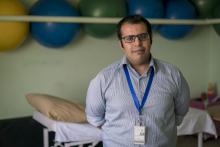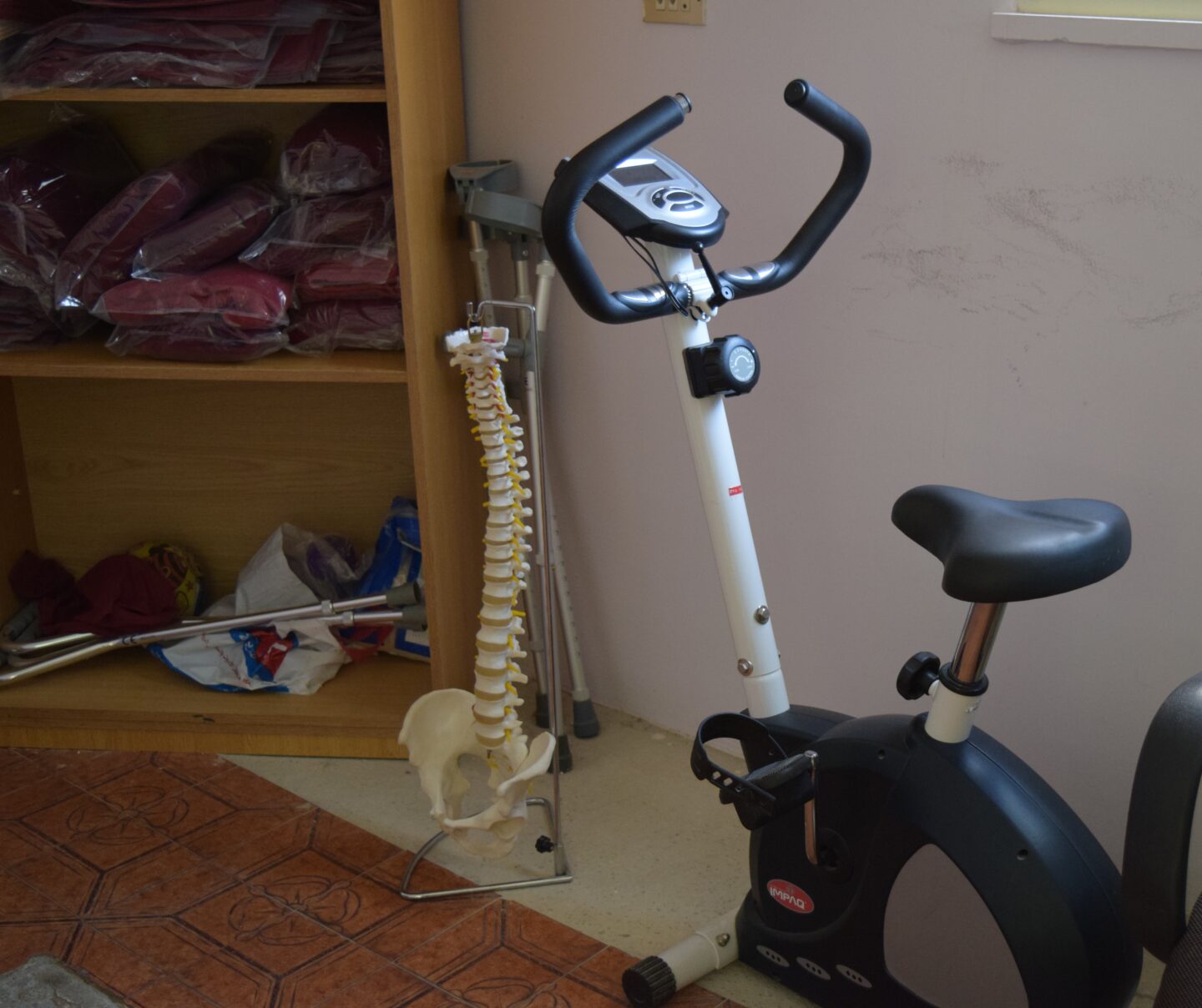Physiotherapy to Help Survivors of Torture in Their Darkest Hours
Most people will have the experience of having a nightmare at some time. It’s not pleasant, but we deal with it. For a survivor of torture, however, a nightmare can be an extremely difficult situation. During a nightmare, the torture survivor relives his trauma. And by “relive” I mean it’s like a video he is watching of the experience. His body reflects this in his sleep. He may wake up in the same position as when he was tortured. This is one of the things I help people with in my work as a physiotherapist at CVT.
Tuesday, April 12, 2016
Mohammed Qtaishat is a physiotherapist at CVT Jordan.

Photo by Christopher Herwig.
Most people will have the experience of having a nightmare at some time. It’s not pleasant, but we deal with it. For a survivor of torture, however, a nightmare can be an extremely difficult situation. During a nightmare, the torture survivor relives his trauma. And by “relive” I mean it’s like a video he is watching of the experience. His body reflects this in his sleep. He may wake up in the same position as when he was tortured. This is one of the things I help people within my work as a physiotherapist at CVT.
I help clients develop ways to cope with nightmares and many, many more symptoms that result from torture. I’ve been doing physical therapy for more than eight or nine years. I chose to pursue physiotherapy because I was a football player in my youth, and there was a medical team for the athletes: a physician and a physiotherapist. They worked well with all the players, and I noticed what a difference the physiotherapy made. I liked these guys.
During my time at the University, I had an internship at a hospital and a rehabilitation center, doing research all over the country for a year. I also did an internship with children with cerebral palsy through an NGO. After I graduated, I worked at a hospital for over two years and received an offer as chief physiotherapist in the rehabilitation center. There, we incorporated physiotherapy and Traditional Chinese Medicine (TCM), including acupuncture. It was a large team with a multidisciplinary approach, including doctors and nurses. I then started my masters in kinesiology and exercise science.
Then one day, I was browsing the Internet, and I saw CVT needed a physiotherapist. I noticed the name of the center and thought, what is that? What do they do? I looked up CVT online. First I saw this blog. I read a lot about the staff. I read the client stories. I was touched. I thought about how my father did tours with the UN. He was enthusiastic about humanitarian work and shared with us that it’s important to make a person’s life better. He told us to help others. And you want to be like your father.
So I applied. During my interview, I think I asked more questions than I answered.
As physiotherapists, we help people afflicted by injuries and especially at CVT, with training. We help with movement, exercises, manual therapy, education and advice. We correct their misbeliefs about health conditions. This is especially important for people with post-traumatic stress disorder (PTSD). They have misconceptions when it comes to pain. Everyone has his or her own version of pain, but not all see why it happens. Pain indicators are the body saying something’s wrong. But torture survivors confuse acute pain with chronic pain. Our clients’ pain is amplified – this is how trauma affects the body. In cases of chronic, or long-term pain, the individual still experiences pain, even though the tissues, ligaments and joints may have all healed.

With survivors, we need to do movement, certain exercises and education. Movement sends a message to the brain, a signal that things are okay now. With continued practice, time and strengthening, the pain will decrease. For persistent pain issues, we help them to cope with it. Outside research has shown that the best techniques for chronic pain are the things we do here: breathing, relaxation, movement exposure.
At CVT, physiotherapists, psychosocial counselors and social workers work together. It’s a holistic approach. Our physiotherapy is about the mind-body connection.
Trauma affects people on multiple levels: psychological, social, emotional and physical. Let’s say you have a toothache – would you be happy? No. You would not be your ordinary self. And vice versa – when you are feeling down or sad, it affects your body. I might get a headache or feel pain or dizziness. There’s a strong link between the body and mind.
There are certain changes to the body after trauma: Clients may have a high rate of vigilance, intrusive thoughts and flashbacks. There may be changes to one’s breathing rate and pain, and people exhibit the physical signs of PTSD. Those who have survived torture are in a high arousal state, so their pain is intensified and sleep is affected. Healthy sleep is very important; the majority of our clients don’t get healthy sleep.
We don’t only help them function well during their daily activities, but beyond that – we teach them coping skills on the physical side. As an example of a need for these coping skills, one thing that is very strongly linked to sleep, vigilance and pain is nightmares. As I mentioned, for a survivor of torture, a nightmare is a very real, visceral experience. His body becomes very tense. Then when he is fully awake after the nightmare, he can’t get back to sleep. He has the same pain as when he was tortured. For him, this pain is very real.
Our role is to help him cope with the nightmares and intrusive thoughts – we help mentally and physically. We help with things he can do in these moments, and we help give him ways to remember his coping strategies. Over time, the frequency of these incidents begins to reduce.
For a child, we take a different approach. It all depends on the client – not all are the same. We may have a child lie on the mat and think about getting back to a certain moment, something that makes him or her happy. We advise them to get in a comfortable position, perhaps to hold something to ground themselves, perhaps to flex their hands and feet.
While thinking about a happy moment, we ask them to take deep breaths. This helps stimulate the vagus nerve, which helps the body relax and releases hormones like serotonin.
Our clients don’t believe their bodies are safe. They have lost body awareness. We help them regain that, and we encourage them to think of their bodies as safe havens. At CVT we work on the tough cases when it comes to pain and trauma. These are the hardest trauma cases. And what we see at first is only the tip of the iceberg. These individuals have a lot inside.
Emotionally and physically, this work is not as simple as I thought it would be when I started. These people really touch me. I think about them a lot. After I was at CVT for a short while, I found I was thinking about clients and taking my work home with me. I said to my supervisor, “This is exhausting what you’re doing at CVT!”
My supervisor said “At CVT, we have a principle of self-care.” I needed to learn more about this. I was instructed to spend more time doing things I liked to do, finding ways to have fun. So I started remembering what I liked to do. How did I have fun? I thought back a good eight years about things I once did in my younger days; I even went out and bought a video game console. I started going on walks, having ice cream. All these things I hadn’t done in years but that were fun.
Once I found a good balance, I was able to see that this is a great thing we do. Our work here is very unique. We help people in their darkest hours. This keeps me ticking. We help those who are really, really hurting. As CVT, we’re the most appropriate people to help them. We help them in every aspect of functioning. This work allows you to tell yourself there is good in this world, and we are part of it.
Funding for CVT’s work in Jordan is provided by the United States Department of State’s Bureau of Population, Refugees and Migration and the United Nations Voluntary Fund for Victims of Torture.
http://www.cvt.org/blog/healing-and-human-rights/physiotherapy-help-survivors-torture-their-darkest-hours